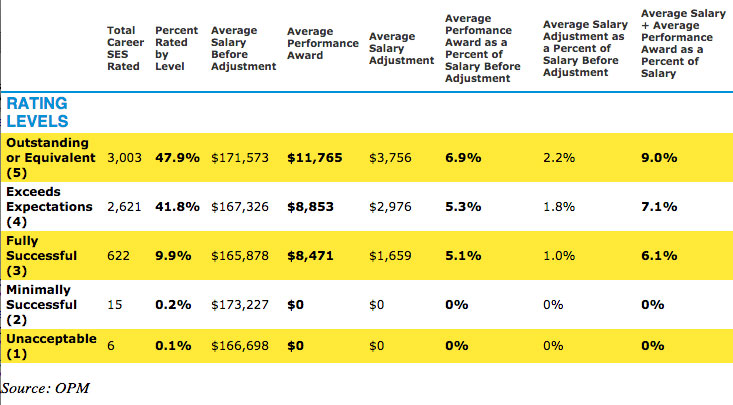
Rrraum / Shutterstock.com
More Senior Execs Got Bonuses in 2014, and the Payouts Were Bigger
The average performance award increased from fiscal 2013 nearly $350 to $10,560.
More senior executives across the federal government got bonuses in fiscal 2014 than in fiscal 2013, and the ones who did received larger awards on average, according to the latest data obtained by Government Executive.
The percentage of career senior executives receiving a bonus based on their job performance increased by 12.2 percentage points between fiscal years 2013 and 2014, to 68.1 percent, according to statistics from the Office of Personnel Management. On average, the amount of individual performance awards also rose $347 -- from $10,213 in fiscal 2013 to $10,560 in fiscal 2014.
The highest average performance award for career senior executives in fiscal 2014 among agencies reporting data to OPM was $15,333 at the National Science Foundation. The lowest average performance award in that category was $8,434 at the State Department.
The fiscal 2014 report included data on 6,267 career senior executives across government compared to 6,601 senior executives rated in fiscal 2013.
Agencies submitted rating and pay data for more than 7,500 SES members (including career, non-career and term-limited SES); of that group, agencies rated 90.7 percent of SES members, with 48.5 percent rated at the highest level (outstanding or equivalent). Agencies overall rated 92.9 percent of their career senior executives, with 47.9 percent of them rated at the highest level in fiscal 2014, an increase of 2.6 percentage points from fiscal 2013 for that group.
The average performance award in fiscal 2014 for those career senior executives rated at the highest level was $11,765 – an increase of $628 for the same group in fiscal 2013. The percentage of career senior executives rated at the highest level varied widely across the government: For instance, the Justice Department rated 83.1 percent of its senior executives as outstanding or equivalent. At the other end of that spectrum was the Veterans Affairs Department, rating 19.1 percent of its senior executives at the highest level in fiscal 2014.
Federal budget pressures prompted the Office of Management and Budget in 2011 to cap awards to Senior Executive Service and senior-level scientific and professional employees to no more than 5 percent of their aggregate salaries. On average, salaries increased 1.7 percent for career, non-career and limited-term SES members -- $2,780 – between fiscal 2013 and fiscal 2014. The average salary for all senior executives across government in fiscal 2014 was $168,344, according to the data.
It’s worth noting that senior executives are not eligible for locality pay, unlike other federal employees in different pay systems. Locality pay has been frozen for the federal workforce since 2010, but the Obama administration last month finalized its proposal that 102,000 federal employees receive a significant raise next year, creating 13 new locality pay areas.
As for senior executive bonuses, Title 5 of the U.S. Code includes language regarding SES performance awards. “To encourage excellence in performance by career appointees, performance awards shall be paid to career appointees in accordance with the provisions of this section,” states Title 5, Chapter 53, Subchapter 8, Section 5384. “Such awards shall be paid in a lump sum and shall be in addition to the basic pay paid under section 5382 of this title or any award under section 4507 of this title.”
In October, OPM’s new rules creating a more uniform performance evaluation system across government for senior executives took effect. The standardized performance categories are outstanding, exceeds fully successful, fully successful, minimally satisfactory and unsatisfactory. The new appraisal system requires agencies to consider customer and employee perspectives when evaluating SES managers.
The chart below has more information on fiscal 2014 SES bonuses:
(Top image via Rrraum / Shutterstock.com)








